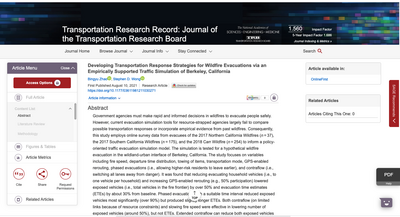 Recent alum Stephen D. Wong and UC Berkeley Civil and Environmental Engineering Post Doc Bingyu Zhao recently published Developing Transportation Response Strategies for Wildfire Evacuations via an Empirically Supported Traffic Simulation of Berkeley, California at Sage Publications.
Recent alum Stephen D. Wong and UC Berkeley Civil and Environmental Engineering Post Doc Bingyu Zhao recently published Developing Transportation Response Strategies for Wildfire Evacuations via an Empirically Supported Traffic Simulation of Berkeley, California at Sage Publications.Abstract
Government agencies must make rapid and informed decisions in wildfires to evacuate people safely. However, current evacuation simulation tools for resource-strapped agencies largely fail to compare possible transportation responses or incorporate empirical evidence from past wildfires. Consequently, this study employs online survey data from evacuees of the 2017 Northern California Wildfires (n = 37), the 2017 Southern California Wildfires (n = 175), and the 2018 Carr Wildfire (n = 254) to inform a policy-oriented traffic evacuation simulation model. The simulation is tested for a hypothetical wildfire evacuation in the wildland-urban interface of Berkeley, California. The study focuses on variables including fire speed, departure time distribution, towing of items, transportation mode, GPS-enabled rerouting, phased evacuations (i.e., allowing higher-risk residents to leave earlier), and contraflow (i.e., switching all lanes away from danger). It was found that reducing evacuating household vehicles (i.e., to one vehicle per household) and increasing GPS-enabled rerouting (e.g., 50% participation) lowered exposed vehicles (i.e., total vehicles in the fire frontier) by over 50% and evacuation time estimates (ETEs) by about 30% from baseline. Phased evacuations with a suitable time interval reduced exposed vehicles most significantly (over 90%) but produced slightly longer ETEs. Both contraflow (on limited links because of resource constraints) and slowing fire speed were effective in lowering number of exposed vehicles (around 50%), but not ETEs. Extended contraflow can reduce both exposed vehicles and ETEs. It is recommended that agencies develop a communication and parking plan to reduce the number of evacuating vehicles, create and communicate a phased evacuation plan, and build partnerships with GPS-routing services.
